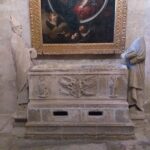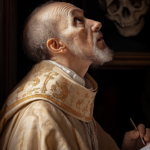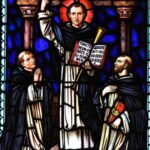St. Anthony Mary Claret
Saint Anthony Mary Claret
St. Antony Mary Claret
When he lived:
St. Antony Mary Claret lived from 1807 to 1870.
Where he lived:
St. Antony Mary Claret lived in Spain and later traveled extensively throughout the world as a missionary.
Notable world events during the time of his life:
- 1815 – End of the Napoleonic Wars: As St. Antony Mary Claret was growing up, the Napoleonic Wars came to an end. This significant event marked the beginning of a new era in Europe and influenced the political and social landscape of the time.
- 1839 – First Opium War Begins: In this year, the First Opium War broke out between China and Great Britain, ultimately resulting in the opening of several Chinese ports to Western trade. This conflict had far-reaching consequences for international relations and trade during St. Antony Mary Claret’s lifetime.
- 1859 – Publication of Charles Darwin’s “On the Origin of Species”: Charles Darwin’s groundbreaking work, published in 1859, revolutionized the field of biology and challenged long-standing religious and scientific beliefs. The publication of this influential book had a profound impact on the intellectual discourse of the time and sparked debates regarding evolution and its implications for faith.
- 1861 – American Civil War Begins: The American Civil War commenced in 1861, leading to a long and devastating conflict between the Northern and Southern states of the United States. This war, fought primarily over issues of slavery and states’ rights, had significant political, social, and economic ramifications both within the United States and worldwide.
- 1869 – Completion of the Suez Canal: The Suez Canal, a monumental engineering feat, was completed in 1869. This artificial waterway connected the Mediterranean Sea to the Red Sea, revolutionizing global trade and transportation by providing a shorter route between Europe and Asia. It had a transformative impact on maritime commerce and geopolitical dynamics.
His patronage:
- Textile Workers: St. Antony Mary Claret worked as a weaver in his early life, and as a result, he is considered the patron saint of textile workers. His experiences in this field and his commitment to social justice and the well-being of workers have made him an inspiration to those employed in the textile industry.
- Missionaries: St. Antony Mary Claret was renowned for his tireless missionary work, particularly as he traveled to different parts of the world spreading the Catholic faith. His dedication and evangelizing efforts have made him a beloved patron saint of missionaries, who seek his intercession and guidance in their own missionary endeavors.
- Claretians: St. Antony Mary Claret founded the religious order known as the Claretians, officially called the Congregation of Missionary Sons of the Immaculate Heart of Mary. As their founder, he is revered as the patron saint of the Claretians, who strive to follow his example of devotion, service, and spreading the Gospel.
- Weavers: St. Antony Mary Claret’s early occupation as a weaver led to his patronage of weavers. Those involved in the textile industry, whether as craftsmen or women, look to him for guidance and support in their work, seeking his intercession for success and protection in their trade.
Early Life
Saint Anthony Mary Claret was born on December 23rd, 1807, in Sallent, Bages, Barcelona. His father was said to have worked as a manufacturer of wool.
Saint Anthony was one of the eleven children born to Juan and Josefa Claret. As a child, he was bright and taught the importance of religion by his devout parents.
He was said to have been baptized in the Church of Santa Maria. Some records say he might have been a pilgrim to Our Lady of Fussimanya shrine at a tender age.
Saint Anthony received primary education in his town. At the age of twelve, he stopped school and became a weaver.
When he turned eighteen, he traveled to Barcelona, where he trained on improving his textile skills. When he wasn’t working, he spent his time praying or studying Latin and French.
Saint Anthony stayed in Barcelona until he was twenty years old. Anxious that he wasn’t giving any time to religion anymore, he left for Vic.
Saint Anthony was convinced that God had plans in store for him. This encouraged him to join the diocesan seminary in 1829. Finally, on June 13, 1835, he was ordained.
He stayed behind to study theology. During this course, he realized his passion for mission work and left in 1839.
Dedication and devotion
Saint Anthony arrived in Rome, where he proceeded to join the Jesuits. He stayed for a while, but his failing health could not keep up with their lifestyle.
Disappointed, he traveled back to Spain, where he became a preacher. Saint Anthony preached in places like Viladrau and Girona. His sermons caused him to become famous and respected by many.
Saint Anthony was also said to have tended to the sick and injured during the war.
He was called back to Vic and then commissioned to preach the gospel through Catalonia. He did this by traveling from place to place on foot.
His sermons were enjoyed by the locals because he spoke Catalan fluently. He spent all his time traveling and preaching the gospel.
Saint Anthony was a kind and soft-spoken man. This, however, did nothing to stop him from making enemies. His life was threatened by those endangered by his preaching, and so he was sent to the Canary Islands for safety.
In the Canary Islands, he continued preaching for about a year and a half. Afterward, he returned to Spain.
Back at home, he built a church for the Claretians. The church was called the Congregation of the Missionary Sons of the Immaculate Heart of Mary. The church was authorized by Pope Pius IX on December 22, 1865.
Saint Anthony also established a religious library in Barcelona called the Librera Claret.
Legacy
In 1849, Saint Anthony was enshrined as Archbishop of Santiago by Pope Pius IX. He was consecrated in October of the following year at Vic.
Soon after he assumed authority, Saint Anthony authorized more than 9,000 marriages and established clinical institutions, schools, and churches. The diocese flourished under his care.
Saint Anthony established the first women’s religious institution in Cuba, the Religious of Mary Immaculate. He would travel to minister in places like hospitals and prisons. Sometimes, in the course of evangelism, he would be assaulted.
There were numerous miracles associated with Saint Anthony. Some records claim that he could calm storms. Others claimed he slipped into ecstasy and could be seen levitating. Some even claimed that while saying Mass, the saint became luminous.
Saint Anthony confessed to the Queen of Spain, Queen Isabella II, in 1857.
He continued to write books on theology and practice poverty. He acted as rector at the Escorial monastic school and established laboratories, museums, and even libraries.
Saint Anthony preached in Paris in 1868, and the following year he was in Rome for the Vatican Council.
As his health continued to deteriorate and he continued to be a target for assault, Saint Anthony escaped to seclusion in the Cisterian monastery at Narbonne.
Death and Canonization
Saint Anthony Mary Claret died on October 24, 1870. He was 62.
Saint Anthony was buried in Vic. He was canonized on May 7, 1950, by Pope Pius XII. It is celebrated on the 23rd or 24th of October.
5 Interesting Facts About St. Anthony Mary Claret
- Did you know that Saint Anthony Mary Claret was ordained on this day?
of the celebration of Saint Anthony of Padua? - Did you know that Saint Anthony was said to have the spiritual gift of
of discernment? - Did you know that Saint Anthony Mary Claret is the patron saint of
Weavers? - Did you know that Saint Anthony was said to have made a regular
pilgrimage to Our Lady of the Pillar, the Virgin of Montserrat, and
Our Lady of Fussimanya? - Did you know that Saint Anthony wrote 144 books in total?
Prayer to St. Anthony Mary Claret
St. Anthony Mary Claret, during your life on earth, you often comforted the afflicted and showed such tender love and compassion for the sick and sinful. Intercede for me now that you rejoice in the reward of your virtues in heavenly glory. Look with pity on me (or on the person afflicted with illness or whose conversion is desired) and grant my prayer, if such be the will of God. Make my troubles your own. Speak a word for me to the Immaculate Heart of Mary to obtain by her powerful intercession the grace I yearn for so ardently and a blessing to strengthen me during life, assist me at the hour of death, and lead me to a happy eternity. Amen.
Source:[https://www.catholicdoors.com/prayers/english4/p02806.htm]{.ul}



